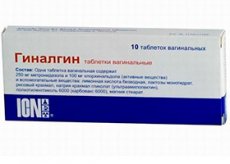Medical expert of the article
New publications
Preparations
Ginalgin
Last reviewed: 03.07.2025

All iLive content is medically reviewed or fact checked to ensure as much factual accuracy as possible.
We have strict sourcing guidelines and only link to reputable media sites, academic research institutions and, whenever possible, medically peer reviewed studies. Note that the numbers in parentheses ([1], [2], etc.) are clickable links to these studies.
If you feel that any of our content is inaccurate, out-of-date, or otherwise questionable, please select it and press Ctrl + Enter.

Indications Ginalgina
It is used for the treatment of infections that appear in the intestinal area (this includes salmonellosis with dysentery, food poisoning, infectious lesions caused by the activity of Proteus, Staphylococcus and other enterobacteria, and, among other things, the destruction of healthy microflora within the body).
Release form
The therapeutic component is released in tablet form, they have a volume of 0.1 g - in the amount of 50 pieces inside the pack. Tablets can also have a volume of 0.03 g - this is a children's dosage.
Pharmacodynamics
The drug has an antifungal, antibacterial and antiprotozoal effect (inhibits the vital activity of protozoan bacteria). The therapeutic element most effectively affects the activity of gram-positive (mostly this concerns cocci) and gram-negative microorganisms.
Pharmacokinetics
When taken orally, the drug is not absorbed in the gastrointestinal tract and therefore does not have a systemic effect.
Dosing and administration
The medication should be taken orally, only after each meal. For an adult, the dosage portion size is 0.2 g, taken three times a day in 24 hours. At mild stages of the disease, 0.1 g is taken with the same frequency. If it is necessary to eliminate a pathology that has a severe course (for example, amebiasis), then up to 1200 mg of the drug is taken per day.
The size of a single children's portion (age 1-2 years) is 30 mg, and a daily portion is 90-120 mg. For children aged 3-6 years - 30-60 mg and 150-180 mg, respectively. For children aged 7-10 years, the corresponding dosages are 60-90 mg and 240-300 mg.
The portion size is calculated based on the child’s weight in proportions of 10 mg/kg; in mild cases of the disease – a maximum of 5 mg/kg.
During the treatment of amebiasis (a disease caused by the dysenteric amoeba; it is characterized by chronic inflammation of the large intestine, which causes ulcerative lesions) or giardiasis (an infection caused by the lamblia), it is permissible to increase the dosage, but to a maximum of 15 mg/kg.
The therapy cycle for all age groups lasts on average 3-5 days (maximum 1 week).
Use Ginalgina during pregnancy
Pregnant or lactating women are prescribed the substance with caution and only in situations where the probable benefit is more expected than the risk of negative consequences for the child or fetus.
Contraindications
Among the contraindications:
- the presence of intolerance to derivatives of the component 8-oxyquinoline (this list includes quinosol with nitroxoline, etc.);
- previously noted allergy symptoms;
- diseases of the kidney or liver, which have a severe form;
- pathologies that destroy the function of the optic nerves;
- lesions within the PNS.
Side effects Ginalgina
Taking the medication may cause headaches or abdominal pain, severe vomiting or rash on the epidermis, nausea and severe palpitations. In such cases, a reduction in the portion size or complete withdrawal of the medication is required.
Among other things, taking Ginalgin and other derivatives of 8-oxyquinoline can lead to the development of the following side effects: polyneuropathy (affecting peripheral nerves, multiple in nature), myelopathy (spinal cord-type diseases, non-inflammatory in nature) and damage affecting the optic nerves.
To avoid such complications, it is necessary to adhere to the regimen of using the drug, following the instructions regarding portion size and duration of administration.
Storage conditions
The medicinal substance is stored in places usual for therapeutic agents.
 [ 5 ]
[ 5 ]
Shelf life
Ginalgin can be used within 24 months from the date of manufacture of the medication.
Attention!
To simplify the perception of information, this instruction for use of the drug "Ginalgin" translated and presented in a special form on the basis of the official instructions for medical use of the drug. Before use read the annotation that came directly to medicines.
Description provided for informational purposes and is not a guide to self-healing. The need for this drug, the purpose of the treatment regimen, methods and dose of the drug is determined solely by the attending physician. Self-medication is dangerous for your health.

